Corsets! How else do you think all those noble ladies of Europe, some hundreds of years ago, managed to look like an hourglass, with a waist that you could span with a hand? The women of those times squeezed their upper body inside a corset. And this lacing up inside a tight corset was a regular dressing routine of ladies from the period from 1560 – 1910.
What is a corset?
- What is a corset?
- Modern day corsets
- Different types of corsets
- 1. Hourglass Corset
- 2. Pipe Stem Corset
- 3. Wasp corsets
- 4. S curve corset
- 5. Straight front corset or Gibson Girl corset
- 5. Ribbon corset
- 6. Tube corset
- 7. Corselette
- 8. Corset belt (Waist-cincher)
- 9. Front laced / front and back laced corset
- 10. Over bust corset
- 11. Under bust corset
- 12. Mid bust corset
- 13. Waspie
- 14. Guepiere corset
- 15. Renaissance Corsets
- 16. Elizabethan Corset
- 17. Victorian corset
- 18. Edwardian Corsets
- 19. Baroque corsets
- 20. Georgian corsets
- 21. Modern corsets
- 22.Corset tops
- 23. Burlusque inspired corsets/ showgirl corsets
A corset is an undergarment for women designed to reduce the waistline – It can lift up the bust line and give the illusion of a long and lean torso with a cinched in waistline. Corsets can be made of lace, velvet, brocade, leather or cotton or twill and fitted with garters and will have stay pockets filled with boning. If it is worn as innerwear the fabric should have breathability, so a 100% cotton is preferred.
The act of getting into the corset is called “Corseting” and it involved the corset manipulating the womanly curves, lifting up the bust, making the shoulders and hips looking wider in comparison to a squeezed in waist.
Some interesting facts as I Promised
Noblewomen in European countries started to use Corsets under their gowns and even over their gowns by the late 1500s. It was called stays then. It was only by 1700s that the word Corset started to be used.
Many Men of olden times used Corsets – to hold in their protruding belly.
Like any garment, corset also changed greatly over the years. In England, the ladies of the Victorian period wore differently shaped corsets than the ones in the Tudor and Elizabethan period. Today’s corset is more easy to fit and easy to care, just like our modern clothing.
Corset training was a ritual then. One fine day, if you try to get into a corset you will not get that really sculpted waist; in fact, you will not be able to lace it properly. It takes some months of corset training for the body to be fully laced into a tight-fitting traditional corset that satisfied the vanity of the lady and satisfied the dimensions of perfection that the society wanted. A Training corset was earlier used (from adolescent age) to train the waist to be a little smaller than it already was. It took several wearings to fit into the final corset.
If you are getting a corset, it will be in a size several inches ( usually 4 inches or so) lower than your body girth. You are then tightly laced inside it. It took hours for a lady and her maids to finish dressing.
The modern-day bra is a derived form of the corset; it supports the bust but does not confine the waist.
Modern day corsets
Today’s corset is a lot different from the ones used all those years ago. For one, the perception of body shapes has changed drastically. And women have also changed and their needs too. When you want good old curves nothing like a good corset – it easily takes off an inch or two from the body girth. But Convenience and comfort are as important as a desire for femininity.
Buying a corset today depends on the garment you will be wearing it under, the money you are prepared to spend and whether you will be wearing it over the clothing or under it, and whether your aim is to just reduce the waist for a function/show etc or two (use and throw) or in a permanent way. Many different types of corsets do different things – all of them reduce waist but some also minimize the bust shape, some thrust out the breasts, some smoothen the hip shape etc.
Today you do not have a maid to lace your corsets. You might only have an impatient husband not at all ready to get into the lace of things. So it is also important that you will be able to wear it by yourself. So ease of dressing is an important factor.
Let us have a look at the different types of corsets that women used and the different body profiles and waistlines they created. ( and still do)
Different types of corsets
According to the silhouette
1. Hourglass Corset
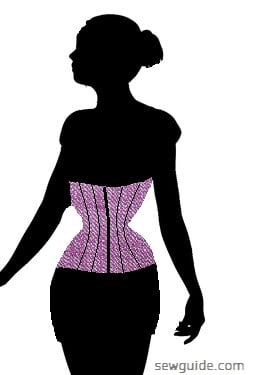
This is the most traditional style of corsets – the classic Victorian corset. Hourglass corset gives you a perfect hourglass figure with a really small waist. The lower ribs are not compressed with this clothing. Just the waist is cinched. It can start from over bust, under bust or mid bust, have a straight neckline or a sweetheart style.
It is a good style of corset in terms of comfort, ease of dressing and maximum waist reduction. But this is not a super flattering silhouette ( in corset standards) as the top of the body or the hip area is not as compressed as the waist.
2. Pipe Stem Corset
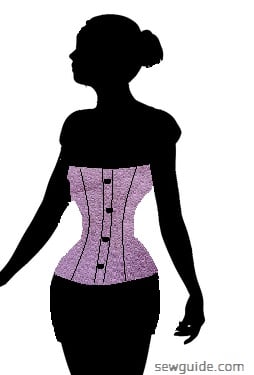
In this style the body is compressed throughout the torso, leading to a look of an especially long torso. Rigid boning is used to create an illusion of length to the torso.
Somewhat severe strain to the lower ribs is the main disadvantage of this type – You cannot wear this type of corsets for a long period. Regular waist training is needed to fit into this type of corset.
3. Wasp corsets
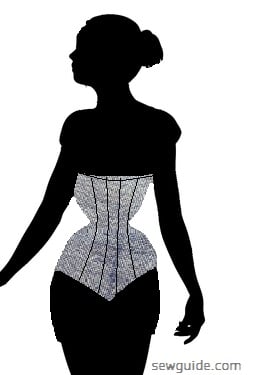
This style of corset is meant to create impossibly small waists by dramatically nipping at the waist and cutting the body almost into half. Named so because you look like a wasp with the segmented body. This creates a bit of a strain in the rib cage and abdomen.
4. S curve corset
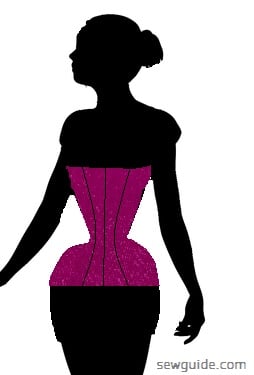
This type of corset resulted in a figure with the chest thrust out, and the hips pushed back creating an S shape to the torso. This corset had an inflexible busk and supporting steels at the front (instead of the inward curving busk fashionable till then) which resulted in this curved shape. It was very popular during the beginning of the 20th century.
When it first came about, this was a corset style that was perceived to be more comforting to the body than any other type because it supported the abdomen but it proved to be more restricting than others – it can reduce the waist to as much as 3 inches and the shape is a little unnatural.The profile it created were called S curve, kangaroo profile.
5. Straight front corset or Gibson Girl corset
This is a slightly different version of the S-curve corset. It has a more natural and graceful appearance compared to the tightly cinched waists of previous eras. The profile it created is called the Gibson profile. It supports and pushes the bust out and up while drastically compressing the waist. It also pushes the stomach in and the hips back.
5. Ribbon corset
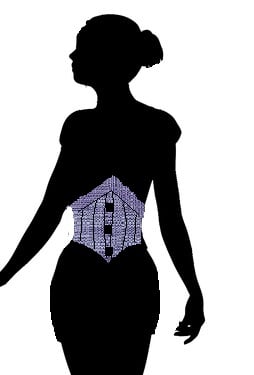
A ribbon corset is an everyday wear corset made of lightweight materials (strips of fabric). It is very easy to wear and not so tight fitting as others. You can call it the modern day corset.
6. Tube corset
This corset fits tightly at the top to shape the bust, pushing it up or flattening it down. It is laced up at the back and might have a busk in the front. It narrows slightly at the waist and covers the hips. This corset gives a smooth, straight look to the torso. The boning is usually in channels along the seams, about one bone every inch to three inches. Sometimes, there’s a sturdy busk in the front that can either flatten the chest or separate the breasts.
According to the size/ position/ length
7. Corselette
This in the traditional sense means a corset that is long and continues to the hip.
8. Corset belt (Waist-cincher)
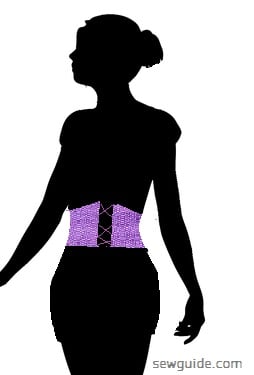
This is a short corset that will just cover the waist area. It almost seems like a wide belt. It will give you only a small waist compression compared to other corsets
9. Front laced / front and back laced corset
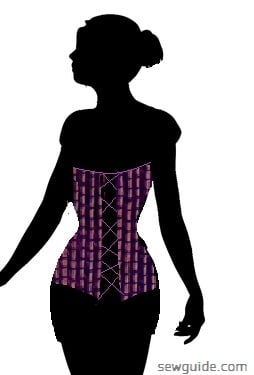
This classification is based on the appearance of lacing. The corset can be laced up the front alone or front and back or even have triple lacing.
10. Over bust corset
This is the typical corset worn as an outer garment, as a top or as the bodice of wedding gown. As the name suggests it goes over the bust. The corset has a slightly curved front to support the bust and push it up.
11. Under bust corset
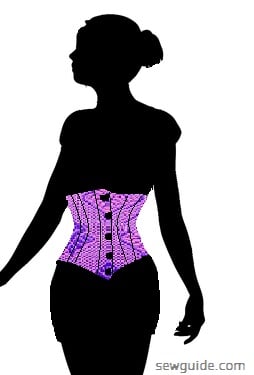
This type of corset starts under the bust line and still creates the classic hourglass waist profile.
12. Mid bust corset
This type of corset starts from mid-bust.
13. Waspie
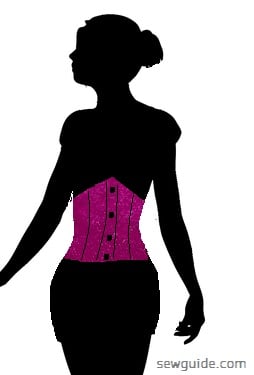
This is a short corset that starts under the ribs and extends to the top of the hips. This is a modern corset first introduced by Fashion designer Christian Dior and has elastic panels in the back giving it the stretch with back lacing.
14. Guepiere corset
This is a signature corset made popular by the French fashion designer Christian Dior during the 1940s and 1950s. It combines bustier, waist clincher and garter belt into a single garment. Also called Basque.
According to the Time period
15. Renaissance Corsets

Renaissance period extended from the 14th to the 17th century. The shape of the corset of this period molded the torso into a conical shape. The bust was pushed up.
16. Elizabethan Corset
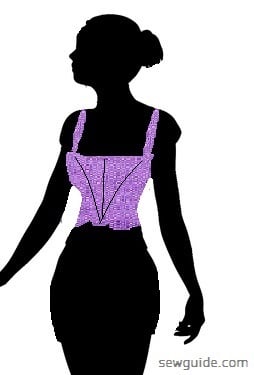
Corset which was popular during the period of Queen Elizabeth I’s reign in England from 1558 to 1603. This is a waist length corset with shoulder straps and flat sides covering the rib area and front and has back lacing. The way it is made creates an almost dramatically elevated bust line and the bottom edge may have a scalloped edge. The bust was flattened in the front along the torso inside the tight corset but pushed up, creating a dramatic squeezed cleavage and a cone-shaped torso, wide-set shoulders, and large, padded-out hips.
17. Victorian corset
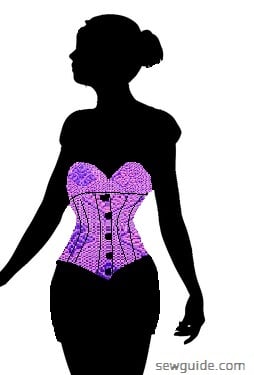
The Victorian period is from 1837-1901 (the ruling period of Queen Victoria). During this time the type of corset used resulted in a classic hourglass waist profile as the waist is tightly cinched and went over bust. The corset has a curved front that lifts and shapes the bust. It laces up at the back and often has a split front with hooks and eyes.
The neckline could be a sweetheart-shaped neckline or a pointed one. There are usually no straps on it. To give structure, boning were placed in channels along the seams, about one bone every inch to three inches.
The bottom also could be pointed in shape. This was not as comfortable as the Elizabethan corset as it squeezed the ribs to compress the waistline.
18. Edwardian Corsets
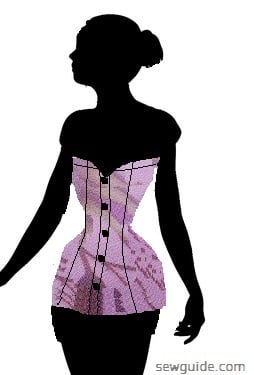
S Curve Corset was fashionable during the early part of the 20th century (1900-1910). Edwardian style corset gave the body an S curve. The waist is cinched really tight, and the corset goes down to the stomach and hips to compress and push the hips back. It comes lower over the hips and thus was longer than the Victorian corsets.
This corset has a rounded front with a split, often fastened by hooks or a steel piece. This lifts and shapes the bust.
19. Baroque corsets
This period spans roughly from the early 17th century to the early 18th century. The corset of this period features a flat front design intended to gently shape the bust downward and mold the torso into a conical form. The front of the bust area is wide, while the back narrows down. The boning is placed close together, making the corset sturdy.
You can lace the corset either at the back or the front. It has straps running horizontally over the upper arms and sits lower on the waist, with a deep basque style.
20. Georgian corsets
The corset of this time has a rounded front that lifts the bust upward and outward. The front of the bust area is wide, while the back is narrower. You can lace it at the back or the front and back. Straps are often seen and are positioned wider on the shoulders. The boning is usually close together, giving the corset a very sturdy structure. The waist can be either at a natural height or lower, with a straight waist or a basque in the front.
21. Modern corsets
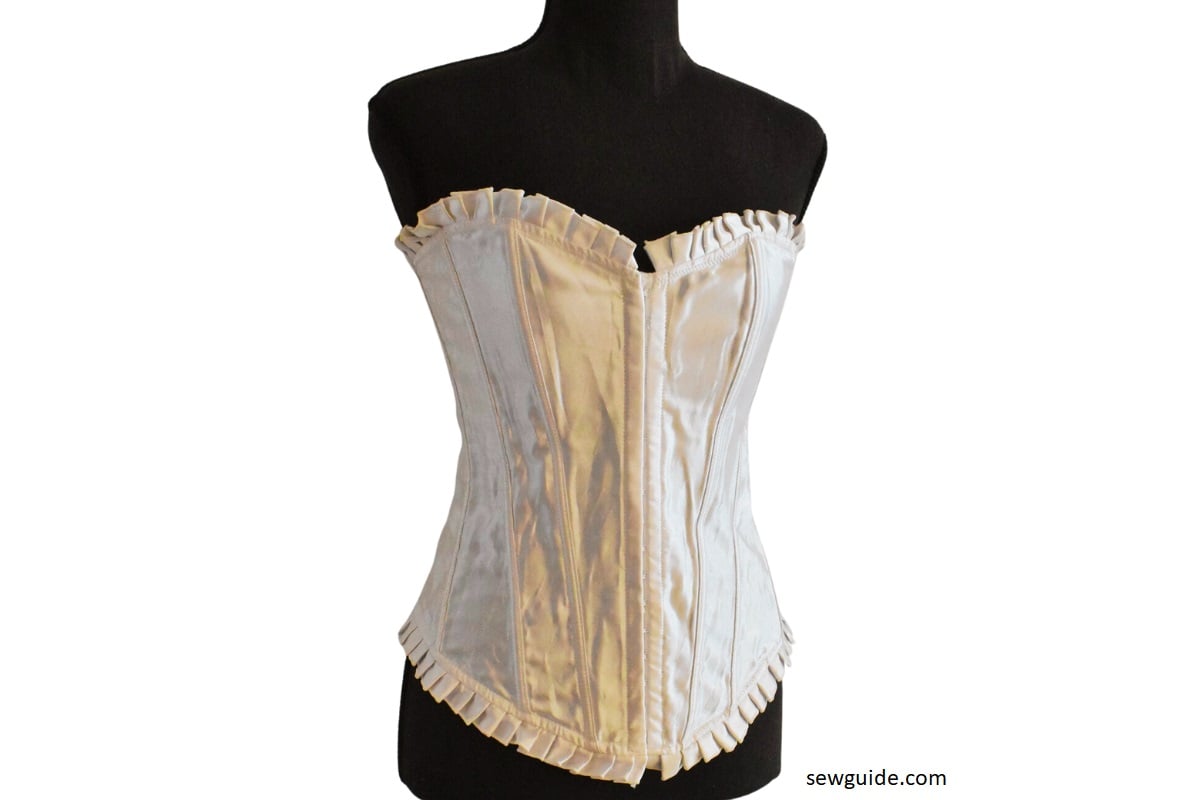 22.Corset tops
22.Corset tops
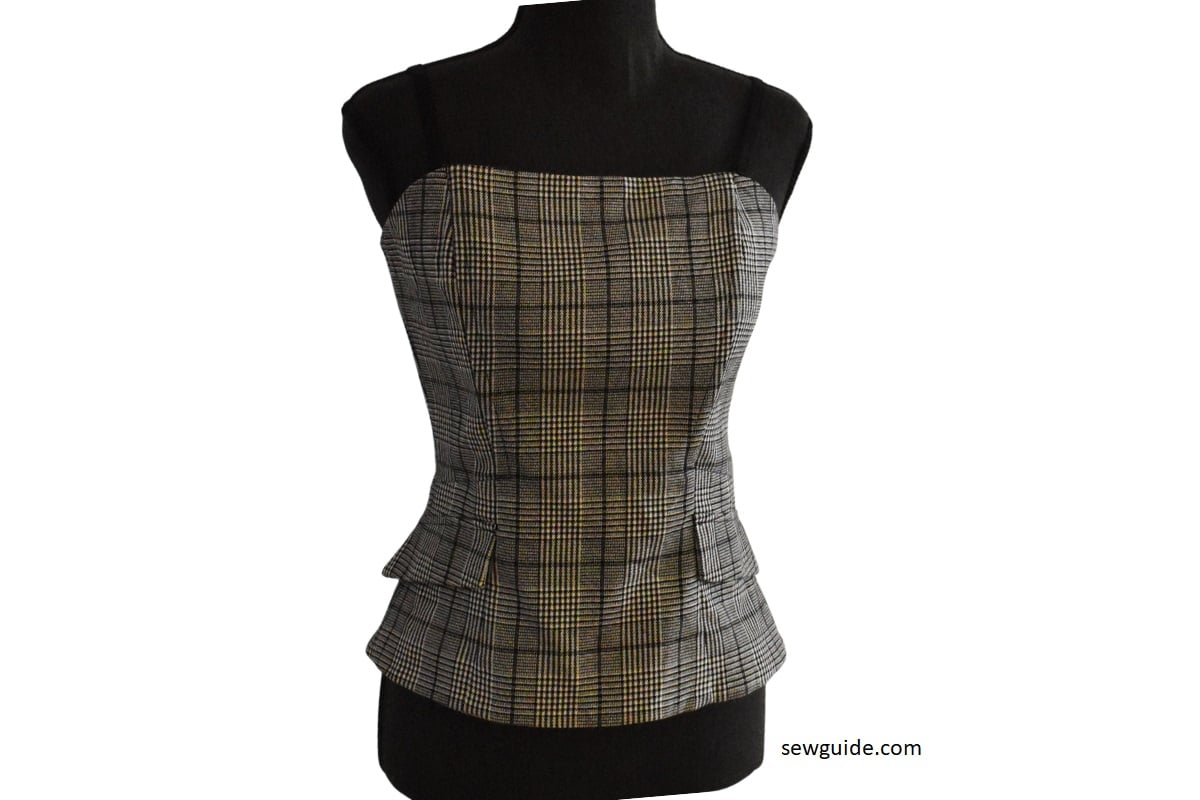
23. Burlusque inspired corsets/ showgirl corsets
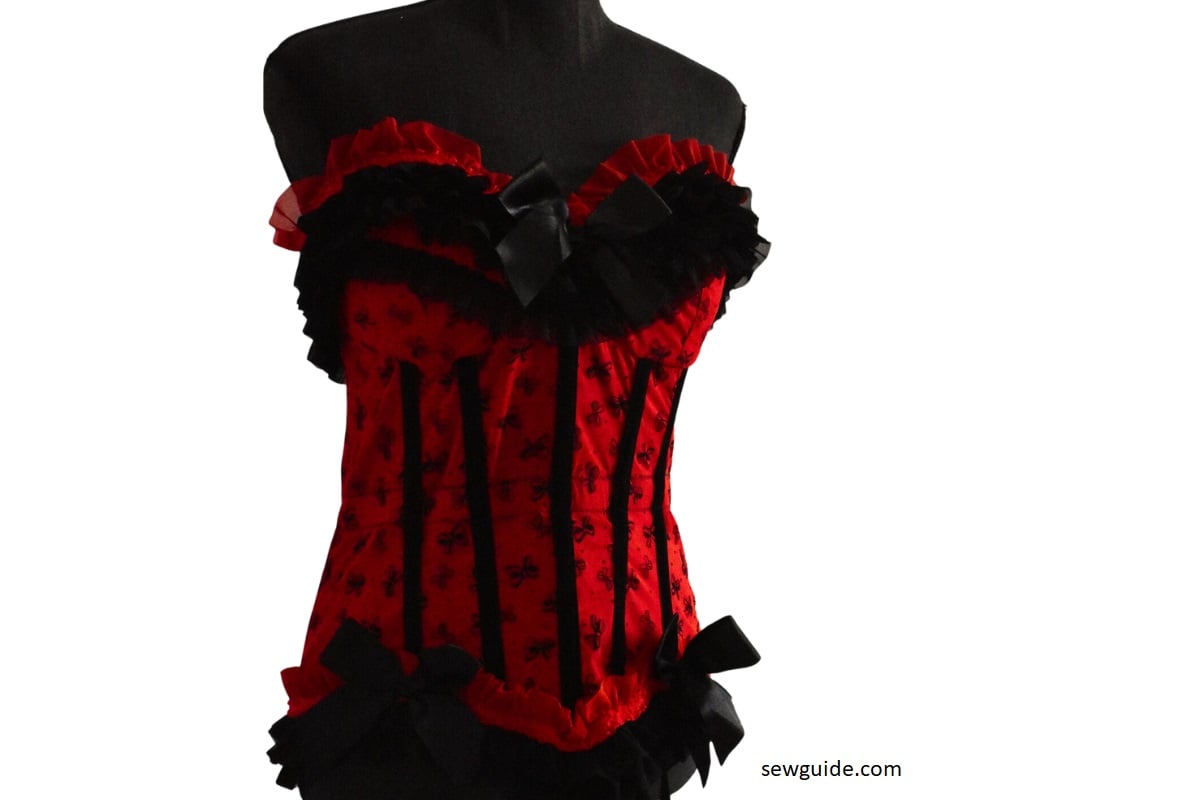
These are corsets which are playful and flirty. They are usually decorated with lots of trims, ruffles, ribbons. A showgirl corset is very beautiful and eyecatching in an attention grabbing, provocative way.
My thoughts on corsets.
The tight lacing in a corset, in my mind, is a symbol of the submissive role that women played in those times. A ‘corsetee’ moves a little bit more carefully and a lot more subdued than one without the confines of the corset. But many others will say that in a corset you walk a little bit more elegantly and gracefully. Yes, the wearer of the corset is perceived as attractive because of the strange waist-hip ratio entrenched in our minds. It is the precursor to the waist/body shapers, girdles and wonder bras we have today.
Wearing a Corset was brutal. Many of the ladies of those times went through many health problems due to the tight lacing of corset. Was, indigestion, heartburn, compression of the inner organs and resultant problems like cramps that beset these ladies because of corseting, worth it all? For them, yes. Vanity is a nuisance, at times.
Related posts : History of Corsets; History of fashion

As others have said, there’s so much misinformation here. The idea that the corset was oppressive and unhealthy is a myth brought about by looking into the past through a modern, ignorant lens. Modern people only ever find corsets uncomfortable because a) they’re not custom made, b) they don’t know how to wear them, and c) they’re not using proper undergarments.
You think women were working and running around unable to breathe just to please “society” as if they were separate from it? Men have never defined women’s fashion (hell, they wore corsets and high heels too in many eras!), and saying women were doing it for them and had no choice, gives them abysmally little credit. Some fashions at various times were even abhorred by men (bloomerism, wide hoop skirts)! And women wore them anyway.
They dressed to their OWN tastes and according to their comfort. They weren’t fainting on couches (those were just roman-inspired daybeds) or deforming their bodies for beauty or even cinching their waists at all in most cases. They used illusion, with big sleeves and hip padding. And those scary looking pictures of wasp waists? Victorians were the first photo editors! Painting them as stupid and helpless spits in the face of their feminism, and ours.
I beg the author or site editors to correct this article and stop the spread of misinformation, or at least take it down. And for anyone who wants to learn about it in more detail, scroll down for links someone else posted.
Can I point you to these articles
https://nyamcenterforhistory.org/2015/05/29/did-corsets-harm-womens-health/https://pubmed.ncbi.nlm.nih.gov/11639434/
https://pubmed.ncbi.nlm.nih.gov/32953334/
But then I also read an article that agrees with what you say too – https://www.smithsonianmag.com/history/what-bridgerton-gets-wrong-about-corsets-180976691/
As we havent lived in those times, it is all interpretations and judgements we make from what we read.
Hate to say it, but I agree with some of the comments about missed opportunities to discuss the fact that everyday women wore corsets, and they generally weren’t a horror. In the period I knew well, France from the Revolution to Waterloo, the “bustier” was very popular – sometimes they even wore an embroidered one OUTSIDE the gown. Its shape was much more in line with a modern brassiere, often with a rising pyramid lifting and separating the breasts. Many tied in front, for easy on and off, and their slim outline was better than a classic corset when worn under the thin muslin gowns of fashion. And it’s probable that, in the country, poor women still practiced some form of breast binding, just a wrap of linen for support.
Corset can or cannot be a horror – but the fact that a woman has to bend and mold her body literally to the dictates of the society’s fashion sensibilities – is what troubles me; and the fact that there was a time when a woman had no choice in this matter.You cannot deny that there was a time when a corset used to change the shape of the body and it took many years of corset training from younger years when they didint know any better. Now, today, I agree that corset is a choice. And it needn’t be as horrible as it was. It can even boost confidence.
Maybe a while later even the bra would be considered the same way as a corset, who knows – something women were forced to wear to cater to the beauty standards of society.
Article contains a lot of misinformation on coursetry. Watch be reset banners videos on the topic to learn wh this information is inaccurate.
This article is quite misleading.
Among other misconceptions, neither stays or corsets were ever dangerous or even uncomfortable, and one can easily run, ride and play tennis wearing a properly fitted one. Also, getting dressed without a maid has always been totally possible and would never take more than a few minutes, regardless of the era. Understand that the preferred supportive garment of a given era was worn by women of ALL classes. Even the fishmongers of the 19th century wore boned corsets ; do you think they wanted/needed to look delicate and submissive ? No, they just happened to have breasts that needed supporting. Do you think opera singers would have performed in corsets if it impeded their breathing ? Hell, even obese women wore them.
For anyone reading this, check out Bernadette Banner’s and Izabella Pitcher’s videos about corsets, they are actual fashion historians and know what they are talking about :
https://www.youtube.com/watch?v=rExJskBZcW0
https://www.youtube.com/watch?v=6_Ogeug8XPc
sexist ? restrictive ? more proof to the contrary :
http://www.thisvictorianlife.com/blog/corset-myths-confronted
https://www.youtube.com/watch?v=J0iLJ4TIjto
https://www.youtube.com/watch?v=a51hQxQAxZI
If you want the truth about what it’s like to wear corsets/stays regularly, why not listen to the women who do just that ? This includes historical costumers and impersonators, but above all, the real women of the past who wore those every as naturally as we would wear a bra today, and still lead the lives that they lead & did the things that that they did, and didn’t once complain about it because it was actually COMFORTABLE.
Hi Alice
That is an interesting perspective. The article is based on what I have read about and obviously there are better learned and experienced people who think different. Thanks for your input.
very insightful, different women with their choices, but I think Victorian corset is more appealing
You say corsets were as enjoyable then as bras are now, but anecdotally at least, I’ve seen significant reports of women who stopped wearing bras because of the quarantine and now don’t want to go back to wearing them. If bras were natural, it wouldn’t be so hard to find one that fits, and there wouldn’t be such a high percentage of women who wear the wrong size. Sites like SewGuide are wonderful because the more you understand the construction and workings of an object, the more you can bring it into your own life.
I know people of many sizes who wear corsets routinely now, and they all need help putting one on, and it’s never a “few minutes” process. They wear corsets for fun because that’s an option now. But it is a fact that women’s clothes are subject to more social prescription than men’s clothes, and to greater discomfort. My mother was obliged, for example, to wear hose and high heels to work. She certainly didn’t want to. That some women enjoy wearing heels sometimes – and again, I have heels, they’re gorgeous and I love them – doesn’t mean it should be socially mandatory. Most shape objects – heels, corsets, hose, and so on – force your body to be something unnatural. (This is not inherently wrong; antihistamines force your body to go against its natural inclination too.) The more expensive they are, the better the job they’re apt to do. Doubtless there were comfortable corsets, but doubtless they were also very expensive or required a lot of workmanship. Even still, calling it “comfortable” is questionable; who among us has not gotten home and immediately flung off their bra, or yanked off earrings that looked pretty but turned out to weigh a ton?
Again, sites that literally deconstruct these objects are great, because they help us to understand the roles (if any) these objects can take in our lives.
Nice to know your thoughts
I grew up in the 70’s and hated bras, wearing them only when necessary: for work or sports. In the 90’s I discovered corsets, real corsets, custom-made to fit a woman and her lifestyle. When created in the proper size and worn properly, they have been comfortable. And, yes, I put them on by myself in a few minutes because I know how.
Yes, if I have to wear a bra, I fling it off the moment I get home. A corset I may loosen right away, but since I have been able to adjust it (by myself, depending on my outfit that day) during the day, it’s rarely that awful by the time I get home.
There are many styles of corset; getting the right one for your body type is the crucial bit. Most obviously, the difference matters between long-waisted and short-waisted women. When you have the right corset, it fits like a hug. You can cinch it tighter or loosen it over the course of wearing it.
It is frustrating to me to read people speaking so inaccurately about them who clearly have limited experience with them.
Thanks for the input. Nice to know your point of view.
Not to mention the fact that there are very few bra design options (and most of the options that are not foam-dome are hard to find), while corsets came in dozens of shapes and styles for every silhouette in order to suit every body type. Don’t need bust support? We got you covered. Need extra bust support? Covered. Athletic, covered. Equestrian, covered. Maternity, breastfeeding, young, old, covered.
If you look through the old Sears catalog, there are dozens of corsets listed as they all suited a certain need. And they were affordable and able to be purchased by anyone regardless of color or socioeconomic status.
There is a HUGE difference between modern corsets and antique corsets. I have worn both and will never wear a modern corset again, they are dangerous and uncomfortable. An antique reproduction? I will wear that instead of a bra any day.
And I, too, have never needed help putting one on.
Thank you for speaking out and helping to bust these outdated misconceptions. People spreading these misconceptions invalidate the experience of our ancestors.
Oh. And Eliza Hamilton (Alexander Hamilton’s wife) wore a corset (well stays and then corsets) everyday and lived to be 97!